Values, Identity, and Education
VerifiedAdded on 2020/01/23
|11
|3362
|451
Literature Review
AI Summary
This assignment discusses the crucial role of values such as fair play, inclusivity, and diversity in shaping children's identities and fostering a sense of belonging within educational settings. It highlights how these values contribute to making students active participants in conversations and confident learners. The assignment also acknowledges the global recognition of parity and diversity through legal frameworks and professional training in education.
Contribute Materials
Your contribution can guide someone’s learning journey. Share your
documents today.
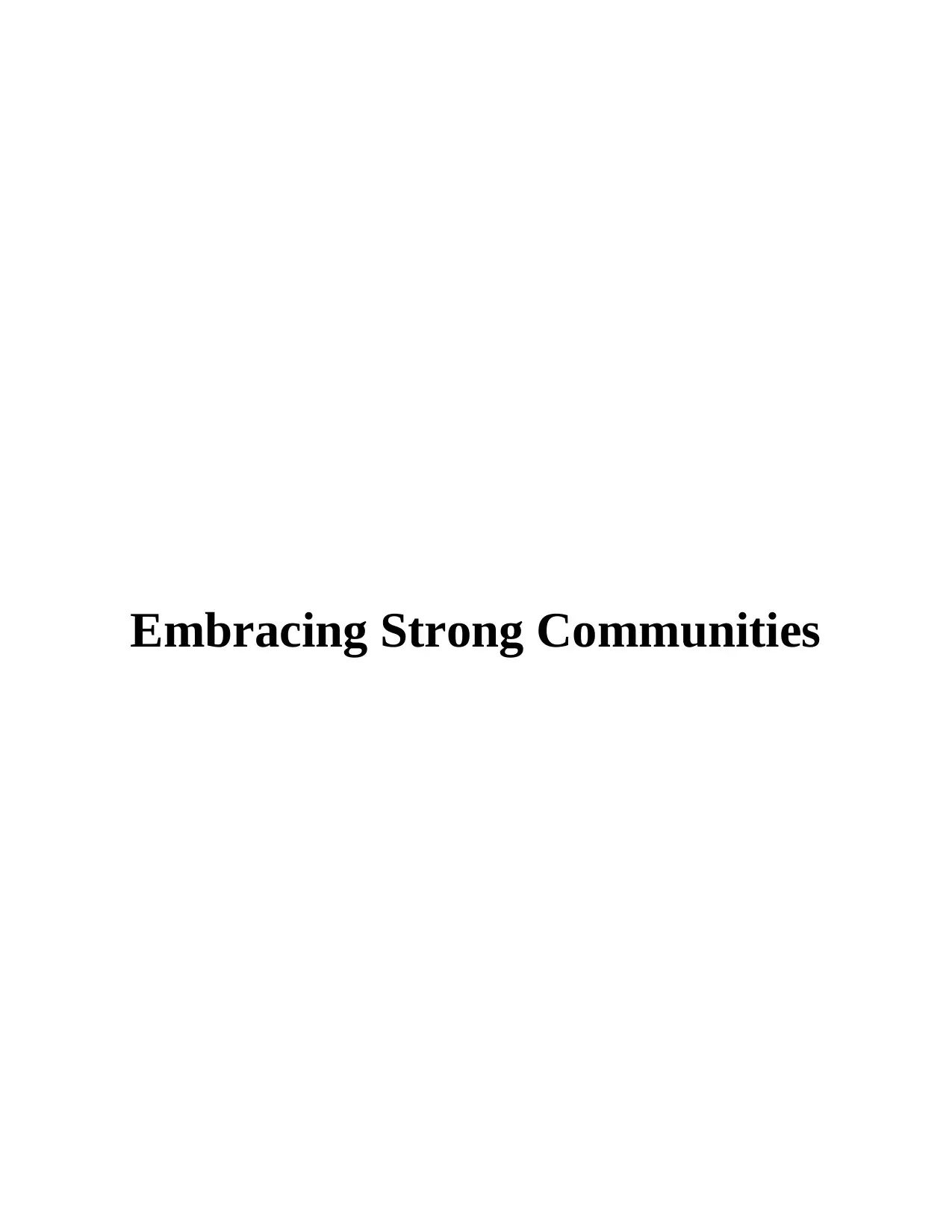
Embracing Strong Communities
Secure Best Marks with AI Grader
Need help grading? Try our AI Grader for instant feedback on your assignments.

TABLE OF CONTENT
INTRODUCTION...........................................................................................................................1
1. Obtaining knowledge..............................................................................................................1
2. Observation.............................................................................................................................3
3. Planning and implementation..................................................................................................4
4. Taking pictures........................................................................................................................5
5. Each day involvement.............................................................................................................6
6. Documenting the project.........................................................................................................7
Covered in PPT...........................................................................................................................7
CONCLUSION................................................................................................................................7
REFERENCES................................................................................................................................8
INTRODUCTION...........................................................................................................................1
1. Obtaining knowledge..............................................................................................................1
2. Observation.............................................................................................................................3
3. Planning and implementation..................................................................................................4
4. Taking pictures........................................................................................................................5
5. Each day involvement.............................................................................................................6
6. Documenting the project.........................................................................................................7
Covered in PPT...........................................................................................................................7
CONCLUSION................................................................................................................................7
REFERENCES................................................................................................................................8

INTRODUCTION
Cultural identity is referred to a vital notion of belongingness in individuals or a group of
individuals where it is also defined to be a crucial part of self-conception in people. It is along
with yet another conceptual framework of self- perception in people where it is mainly
accompanied by the ethnicity, social class, nationality, religion, generation or the locality in
which they are residing (Abrams, Maxwell, Pope and Belgrave, 2014). It is basically to specify a
distinct set of social group where they possess their own cultural belief's. Cultural identity is
reflected to be an important consideration for all social classes where it tends to preserve the
historical percept of the individual by together rendering them a prior sense of belongingness in
their own set of area.
The term of cultural recognition is fundamentally established in case a group of
individuals are continually pursuing an identical norm of their society along with a similar set of
behaviour. This also tends to resemble with their earlier generations as a way of preserving their
historical features. However, cultural is significantly made up of a dynamic composition with
different set of values, inherent assumptions, beliefs, behaviour and attitude that are commonly
shared by the group of individuals (Varney, 2014). Culture is therefore interpreted to be a
behaviour that is usually reflected at the time of group arrival with some unexpressed and
unscripted norms with some elementary standards to work together. A complexed stance of
culture due to its dynamical trait is a major concern that will be showcased in the present study to
detect the ongoing cultural changes in the society that often takes place where it becomes
difficult to address its factual kinetics.
1. Obtaining knowledge
Diversity and cultural competence are the two foremost consideration of individuals to
survive in today's wide-ranging society that reflects distinct origination of people residing over
here. It is mainly in context to two vital events that has necessitated a prior need of cultural
competence. The foremost circumstance is with reference to the movement of civil right that
initially started in the early period of 1950's. This event in turn has involved varied communities
from Africa and America that also included women along with some disabled and minority
groups. At the Hallett Cove, SA., it has been noticed that entire nation about their distinct set of
recognition and long term histories of suppression (Couchenour and Chrisman, 2013). Another
1
Cultural identity is referred to a vital notion of belongingness in individuals or a group of
individuals where it is also defined to be a crucial part of self-conception in people. It is along
with yet another conceptual framework of self- perception in people where it is mainly
accompanied by the ethnicity, social class, nationality, religion, generation or the locality in
which they are residing (Abrams, Maxwell, Pope and Belgrave, 2014). It is basically to specify a
distinct set of social group where they possess their own cultural belief's. Cultural identity is
reflected to be an important consideration for all social classes where it tends to preserve the
historical percept of the individual by together rendering them a prior sense of belongingness in
their own set of area.
The term of cultural recognition is fundamentally established in case a group of
individuals are continually pursuing an identical norm of their society along with a similar set of
behaviour. This also tends to resemble with their earlier generations as a way of preserving their
historical features. However, cultural is significantly made up of a dynamic composition with
different set of values, inherent assumptions, beliefs, behaviour and attitude that are commonly
shared by the group of individuals (Varney, 2014). Culture is therefore interpreted to be a
behaviour that is usually reflected at the time of group arrival with some unexpressed and
unscripted norms with some elementary standards to work together. A complexed stance of
culture due to its dynamical trait is a major concern that will be showcased in the present study to
detect the ongoing cultural changes in the society that often takes place where it becomes
difficult to address its factual kinetics.
1. Obtaining knowledge
Diversity and cultural competence are the two foremost consideration of individuals to
survive in today's wide-ranging society that reflects distinct origination of people residing over
here. It is mainly in context to two vital events that has necessitated a prior need of cultural
competence. The foremost circumstance is with reference to the movement of civil right that
initially started in the early period of 1950's. This event in turn has involved varied communities
from Africa and America that also included women along with some disabled and minority
groups. At the Hallett Cove, SA., it has been noticed that entire nation about their distinct set of
recognition and long term histories of suppression (Couchenour and Chrisman, 2013). Another
1

substantial factor was mainly in regard to specify the growing number of migratory in the nation
that has originated yet newer set of culture with diversified religion, political background and
language, etc.
However, this reflect some historical compliances of such internal shift within their own
states. In addition to this, it can be said on the basis of environment of Hallett Cove that diversity
is resultant consequent of some sort of torture with an extremist state of poverty or governmental
oppression, etc., that tends to destruct the feeling of migrant communities. Thus, by denoting
such type of backgrounds with the experiences and anticipations of U.S. based ethnics. It is
where such diversified population tends to create both prospects of challenge and opportunity for
the social workers. It hereby becomes a major challenge for the migrant bodies to adjust into a
distinct set of culture with a leading concern of the families who are required to bought up their
children in such continually changing environment. This section is basically to obtain a relevant
set of knowledge in association to the Australian Bureau of Statistics (ABS) to identify different
cultural groups in my community.
In context to which, it has been found that Australian Suburb is among the most
diversified societies with different socio- cultural groups in the globe where one out of four is
evident to take birth out of the continent. Along with which, half of the communities have
reflected as Australian Suburb of second generation (Ferdinand, Kelaher and Paradies, 2013). It
where their children and grandchildren has currently arrived as migrators. With reference to
which, it has been found that around 30% population of Australia Suburb are migrants and their
children. Out of which, only 10% of the children among those tends to speak in a different
language other than English.
It is as per the concentrated statistics of 2001 where in the Hallett Cove, SA. state of
Australia there existed more than 120 different ethnic communities who have implied more than
120 distinct languages. This community has reflected 23.3% of individuals who took birth in
overseas areas with only 3.1% people reflected a native background. It is as per the referred data
of ABS that provides the related data of diversified and multiculturalism population for a state by
together stipulating its federal and regional context. Presently, it is with a concentrated ration of
indigenous Australians who are mostly composed of Aboriginal and the channel of Torres Island
where they deals with some major health related issues along with some other problematic
concerns of societal anticipation and ethnic identity.
2
that has originated yet newer set of culture with diversified religion, political background and
language, etc.
However, this reflect some historical compliances of such internal shift within their own
states. In addition to this, it can be said on the basis of environment of Hallett Cove that diversity
is resultant consequent of some sort of torture with an extremist state of poverty or governmental
oppression, etc., that tends to destruct the feeling of migrant communities. Thus, by denoting
such type of backgrounds with the experiences and anticipations of U.S. based ethnics. It is
where such diversified population tends to create both prospects of challenge and opportunity for
the social workers. It hereby becomes a major challenge for the migrant bodies to adjust into a
distinct set of culture with a leading concern of the families who are required to bought up their
children in such continually changing environment. This section is basically to obtain a relevant
set of knowledge in association to the Australian Bureau of Statistics (ABS) to identify different
cultural groups in my community.
In context to which, it has been found that Australian Suburb is among the most
diversified societies with different socio- cultural groups in the globe where one out of four is
evident to take birth out of the continent. Along with which, half of the communities have
reflected as Australian Suburb of second generation (Ferdinand, Kelaher and Paradies, 2013). It
where their children and grandchildren has currently arrived as migrators. With reference to
which, it has been found that around 30% population of Australia Suburb are migrants and their
children. Out of which, only 10% of the children among those tends to speak in a different
language other than English.
It is as per the concentrated statistics of 2001 where in the Hallett Cove, SA. state of
Australia there existed more than 120 different ethnic communities who have implied more than
120 distinct languages. This community has reflected 23.3% of individuals who took birth in
overseas areas with only 3.1% people reflected a native background. It is as per the referred data
of ABS that provides the related data of diversified and multiculturalism population for a state by
together stipulating its federal and regional context. Presently, it is with a concentrated ration of
indigenous Australians who are mostly composed of Aboriginal and the channel of Torres Island
where they deals with some major health related issues along with some other problematic
concerns of societal anticipation and ethnic identity.
2
Paraphrase This Document
Need a fresh take? Get an instant paraphrase of this document with our AI Paraphraser
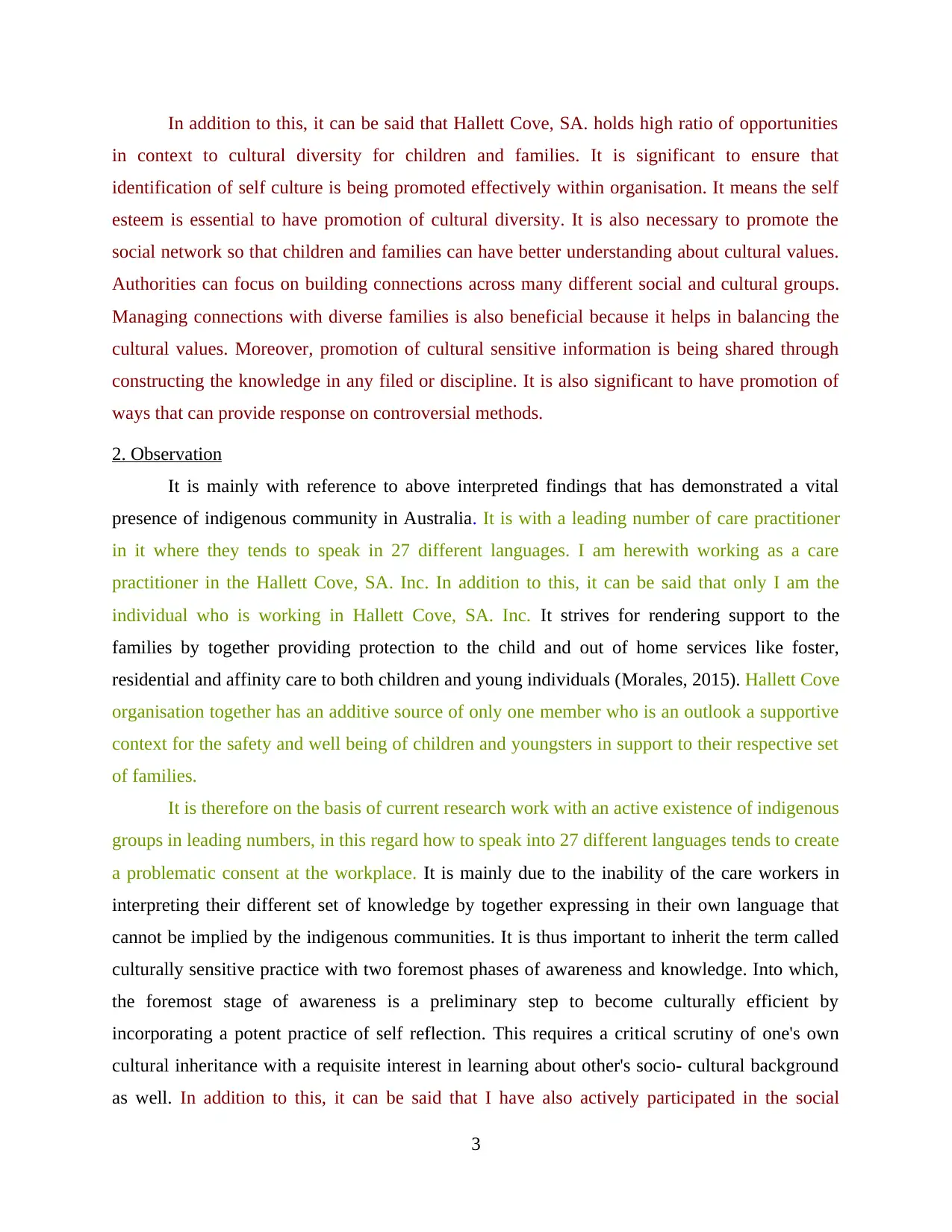
In addition to this, it can be said that Hallett Cove, SA. holds high ratio of opportunities
in context to cultural diversity for children and families. It is significant to ensure that
identification of self culture is being promoted effectively within organisation. It means the self
esteem is essential to have promotion of cultural diversity. It is also necessary to promote the
social network so that children and families can have better understanding about cultural values.
Authorities can focus on building connections across many different social and cultural groups.
Managing connections with diverse families is also beneficial because it helps in balancing the
cultural values. Moreover, promotion of cultural sensitive information is being shared through
constructing the knowledge in any filed or discipline. It is also significant to have promotion of
ways that can provide response on controversial methods.
2. Observation
It is mainly with reference to above interpreted findings that has demonstrated a vital
presence of indigenous community in Australia. It is with a leading number of care practitioner
in it where they tends to speak in 27 different languages. I am herewith working as a care
practitioner in the Hallett Cove, SA. Inc. In addition to this, it can be said that only I am the
individual who is working in Hallett Cove, SA. Inc. It strives for rendering support to the
families by together providing protection to the child and out of home services like foster,
residential and affinity care to both children and young individuals (Morales, 2015). Hallett Cove
organisation together has an additive source of only one member who is an outlook a supportive
context for the safety and well being of children and youngsters in support to their respective set
of families.
It is therefore on the basis of current research work with an active existence of indigenous
groups in leading numbers, in this regard how to speak into 27 different languages tends to create
a problematic consent at the workplace. It is mainly due to the inability of the care workers in
interpreting their different set of knowledge by together expressing in their own language that
cannot be implied by the indigenous communities. It is thus important to inherit the term called
culturally sensitive practice with two foremost phases of awareness and knowledge. Into which,
the foremost stage of awareness is a preliminary step to become culturally efficient by
incorporating a potent practice of self reflection. This requires a critical scrutiny of one's own
cultural inheritance with a requisite interest in learning about other's socio- cultural background
as well. In addition to this, it can be said that I have also actively participated in the social
3
in context to cultural diversity for children and families. It is significant to ensure that
identification of self culture is being promoted effectively within organisation. It means the self
esteem is essential to have promotion of cultural diversity. It is also necessary to promote the
social network so that children and families can have better understanding about cultural values.
Authorities can focus on building connections across many different social and cultural groups.
Managing connections with diverse families is also beneficial because it helps in balancing the
cultural values. Moreover, promotion of cultural sensitive information is being shared through
constructing the knowledge in any filed or discipline. It is also significant to have promotion of
ways that can provide response on controversial methods.
2. Observation
It is mainly with reference to above interpreted findings that has demonstrated a vital
presence of indigenous community in Australia. It is with a leading number of care practitioner
in it where they tends to speak in 27 different languages. I am herewith working as a care
practitioner in the Hallett Cove, SA. Inc. In addition to this, it can be said that only I am the
individual who is working in Hallett Cove, SA. Inc. It strives for rendering support to the
families by together providing protection to the child and out of home services like foster,
residential and affinity care to both children and young individuals (Morales, 2015). Hallett Cove
organisation together has an additive source of only one member who is an outlook a supportive
context for the safety and well being of children and youngsters in support to their respective set
of families.
It is therefore on the basis of current research work with an active existence of indigenous
groups in leading numbers, in this regard how to speak into 27 different languages tends to create
a problematic consent at the workplace. It is mainly due to the inability of the care workers in
interpreting their different set of knowledge by together expressing in their own language that
cannot be implied by the indigenous communities. It is thus important to inherit the term called
culturally sensitive practice with two foremost phases of awareness and knowledge. Into which,
the foremost stage of awareness is a preliminary step to become culturally efficient by
incorporating a potent practice of self reflection. This requires a critical scrutiny of one's own
cultural inheritance with a requisite interest in learning about other's socio- cultural background
as well. In addition to this, it can be said that I have also actively participated in the social
3
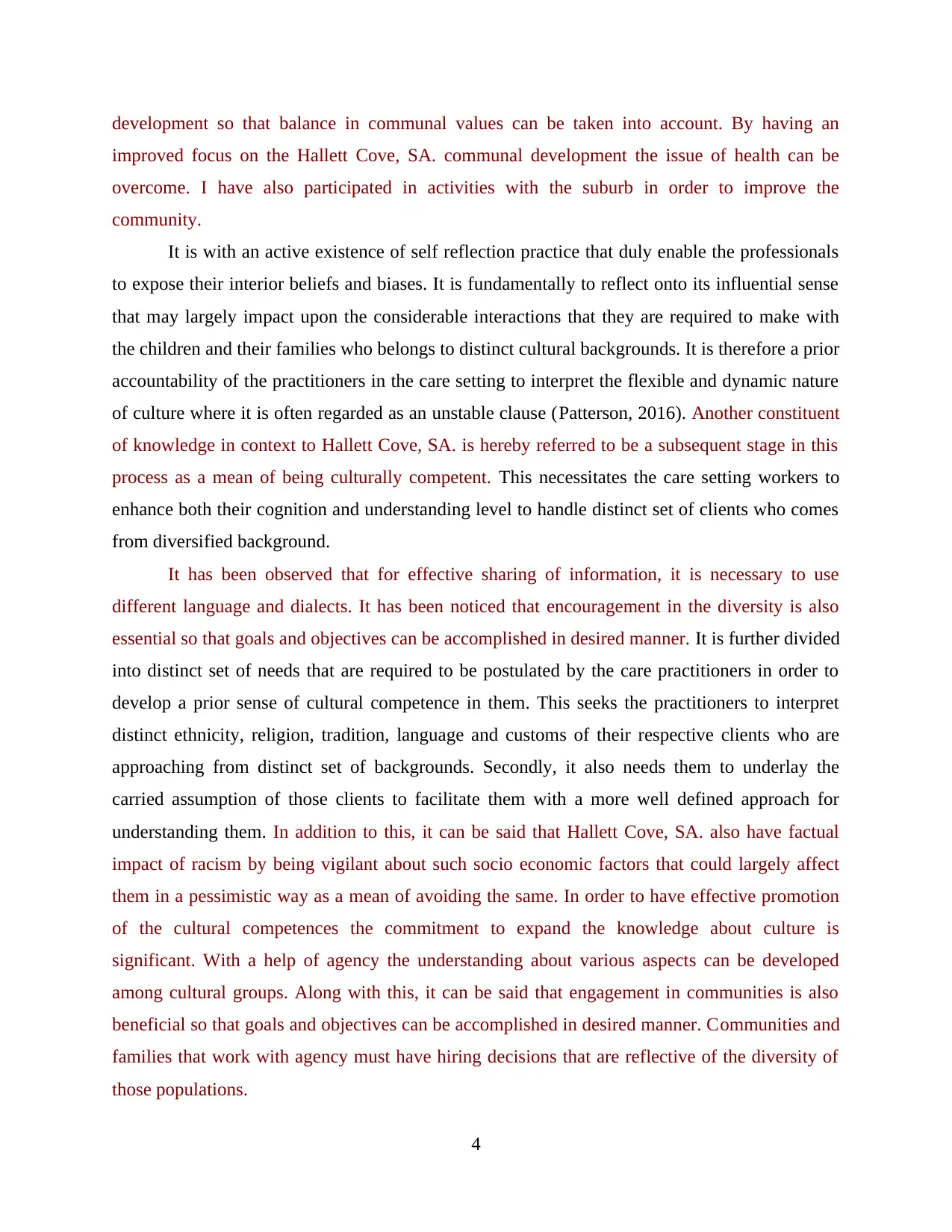
development so that balance in communal values can be taken into account. By having an
improved focus on the Hallett Cove, SA. communal development the issue of health can be
overcome. I have also participated in activities with the suburb in order to improve the
community.
It is with an active existence of self reflection practice that duly enable the professionals
to expose their interior beliefs and biases. It is fundamentally to reflect onto its influential sense
that may largely impact upon the considerable interactions that they are required to make with
the children and their families who belongs to distinct cultural backgrounds. It is therefore a prior
accountability of the practitioners in the care setting to interpret the flexible and dynamic nature
of culture where it is often regarded as an unstable clause (Patterson, 2016). Another constituent
of knowledge in context to Hallett Cove, SA. is hereby referred to be a subsequent stage in this
process as a mean of being culturally competent. This necessitates the care setting workers to
enhance both their cognition and understanding level to handle distinct set of clients who comes
from diversified background.
It has been observed that for effective sharing of information, it is necessary to use
different language and dialects. It has been noticed that encouragement in the diversity is also
essential so that goals and objectives can be accomplished in desired manner. It is further divided
into distinct set of needs that are required to be postulated by the care practitioners in order to
develop a prior sense of cultural competence in them. This seeks the practitioners to interpret
distinct ethnicity, religion, tradition, language and customs of their respective clients who are
approaching from distinct set of backgrounds. Secondly, it also needs them to underlay the
carried assumption of those clients to facilitate them with a more well defined approach for
understanding them. In addition to this, it can be said that Hallett Cove, SA. also have factual
impact of racism by being vigilant about such socio economic factors that could largely affect
them in a pessimistic way as a mean of avoiding the same. In order to have effective promotion
of the cultural competences the commitment to expand the knowledge about culture is
significant. With a help of agency the understanding about various aspects can be developed
among cultural groups. Along with this, it can be said that engagement in communities is also
beneficial so that goals and objectives can be accomplished in desired manner. Communities and
families that work with agency must have hiring decisions that are reflective of the diversity of
those populations.
4
improved focus on the Hallett Cove, SA. communal development the issue of health can be
overcome. I have also participated in activities with the suburb in order to improve the
community.
It is with an active existence of self reflection practice that duly enable the professionals
to expose their interior beliefs and biases. It is fundamentally to reflect onto its influential sense
that may largely impact upon the considerable interactions that they are required to make with
the children and their families who belongs to distinct cultural backgrounds. It is therefore a prior
accountability of the practitioners in the care setting to interpret the flexible and dynamic nature
of culture where it is often regarded as an unstable clause (Patterson, 2016). Another constituent
of knowledge in context to Hallett Cove, SA. is hereby referred to be a subsequent stage in this
process as a mean of being culturally competent. This necessitates the care setting workers to
enhance both their cognition and understanding level to handle distinct set of clients who comes
from diversified background.
It has been observed that for effective sharing of information, it is necessary to use
different language and dialects. It has been noticed that encouragement in the diversity is also
essential so that goals and objectives can be accomplished in desired manner. It is further divided
into distinct set of needs that are required to be postulated by the care practitioners in order to
develop a prior sense of cultural competence in them. This seeks the practitioners to interpret
distinct ethnicity, religion, tradition, language and customs of their respective clients who are
approaching from distinct set of backgrounds. Secondly, it also needs them to underlay the
carried assumption of those clients to facilitate them with a more well defined approach for
understanding them. In addition to this, it can be said that Hallett Cove, SA. also have factual
impact of racism by being vigilant about such socio economic factors that could largely affect
them in a pessimistic way as a mean of avoiding the same. In order to have effective promotion
of the cultural competences the commitment to expand the knowledge about culture is
significant. With a help of agency the understanding about various aspects can be developed
among cultural groups. Along with this, it can be said that engagement in communities is also
beneficial so that goals and objectives can be accomplished in desired manner. Communities and
families that work with agency must have hiring decisions that are reflective of the diversity of
those populations.
4

3. Planning and implementation
This is the most vibrant section that has demonstrated an enforceable plan to activate a
learning environment to foster an optimistic attitude of children to develop an attitude to
understand the cross cultural aspect. This will include a prime exposure of children to interpret
different set of languages and idioms by appreciatively encouraging the practice of lingual
diversity (CFCS, 2013). In context to which, a cross culture learning is that arena of study that
outlook the way in which people belonging to distinct set of communities are referring to interact
with one another. It basically showcases the concept of intercultural communication that is
strategical important for the care settings to understand the retrospective belief of their clients in
order to interpret them in a better manner. Non verbal and language differences are the two vital
prospects in it that are required to be eased off by the implemented plan.
To mitigate these differences, I have hereby referred to some conceptual programs by
arranging a lively session of discussion with them. This session has also included brainstorming
sessions to insight different set of behaviour in children. This has further assisted in addressing
the actual interest level of children by conducting some peculiar activity that has also reflected
their common set of interests. It was basically done by conducting case based problem solving
exercises to facilitate their autonomous thinking with a creative sense in it (Evans, Murphy, and
de Jong, 2014). Small group discussions were another impelling source that has largely
encouraged an effective cooperation of children with an increased motivation to make affluent
performances in the arranged activity. It was basically in context to underlay the fact of
brainstorming objectives of learning where the children were given a prior scope of choosing a
common topic that they wanted to discuss upon. Such autonomous approach largely assists them
to engage with a greater sense of participation that in turn enable them to generate creative set of
ideas.
Along with this, it can be said that I have also used video and graphs in order to improve
the cross cultural aspects. It helps in understanding the key values effectively so that learning
about subject can be improved in appropriate manner. I have promoted the figures in regard to
actual interest level of children so that sustainable development can be taken into account in
appropriate manner. Moreover, the non verbal and language differences issues are also being
overcome through application of practical indicators.
5
This is the most vibrant section that has demonstrated an enforceable plan to activate a
learning environment to foster an optimistic attitude of children to develop an attitude to
understand the cross cultural aspect. This will include a prime exposure of children to interpret
different set of languages and idioms by appreciatively encouraging the practice of lingual
diversity (CFCS, 2013). In context to which, a cross culture learning is that arena of study that
outlook the way in which people belonging to distinct set of communities are referring to interact
with one another. It basically showcases the concept of intercultural communication that is
strategical important for the care settings to understand the retrospective belief of their clients in
order to interpret them in a better manner. Non verbal and language differences are the two vital
prospects in it that are required to be eased off by the implemented plan.
To mitigate these differences, I have hereby referred to some conceptual programs by
arranging a lively session of discussion with them. This session has also included brainstorming
sessions to insight different set of behaviour in children. This has further assisted in addressing
the actual interest level of children by conducting some peculiar activity that has also reflected
their common set of interests. It was basically done by conducting case based problem solving
exercises to facilitate their autonomous thinking with a creative sense in it (Evans, Murphy, and
de Jong, 2014). Small group discussions were another impelling source that has largely
encouraged an effective cooperation of children with an increased motivation to make affluent
performances in the arranged activity. It was basically in context to underlay the fact of
brainstorming objectives of learning where the children were given a prior scope of choosing a
common topic that they wanted to discuss upon. Such autonomous approach largely assists them
to engage with a greater sense of participation that in turn enable them to generate creative set of
ideas.
Along with this, it can be said that I have also used video and graphs in order to improve
the cross cultural aspects. It helps in understanding the key values effectively so that learning
about subject can be improved in appropriate manner. I have promoted the figures in regard to
actual interest level of children so that sustainable development can be taken into account in
appropriate manner. Moreover, the non verbal and language differences issues are also being
overcome through application of practical indicators.
5
Secure Best Marks with AI Grader
Need help grading? Try our AI Grader for instant feedback on your assignments.
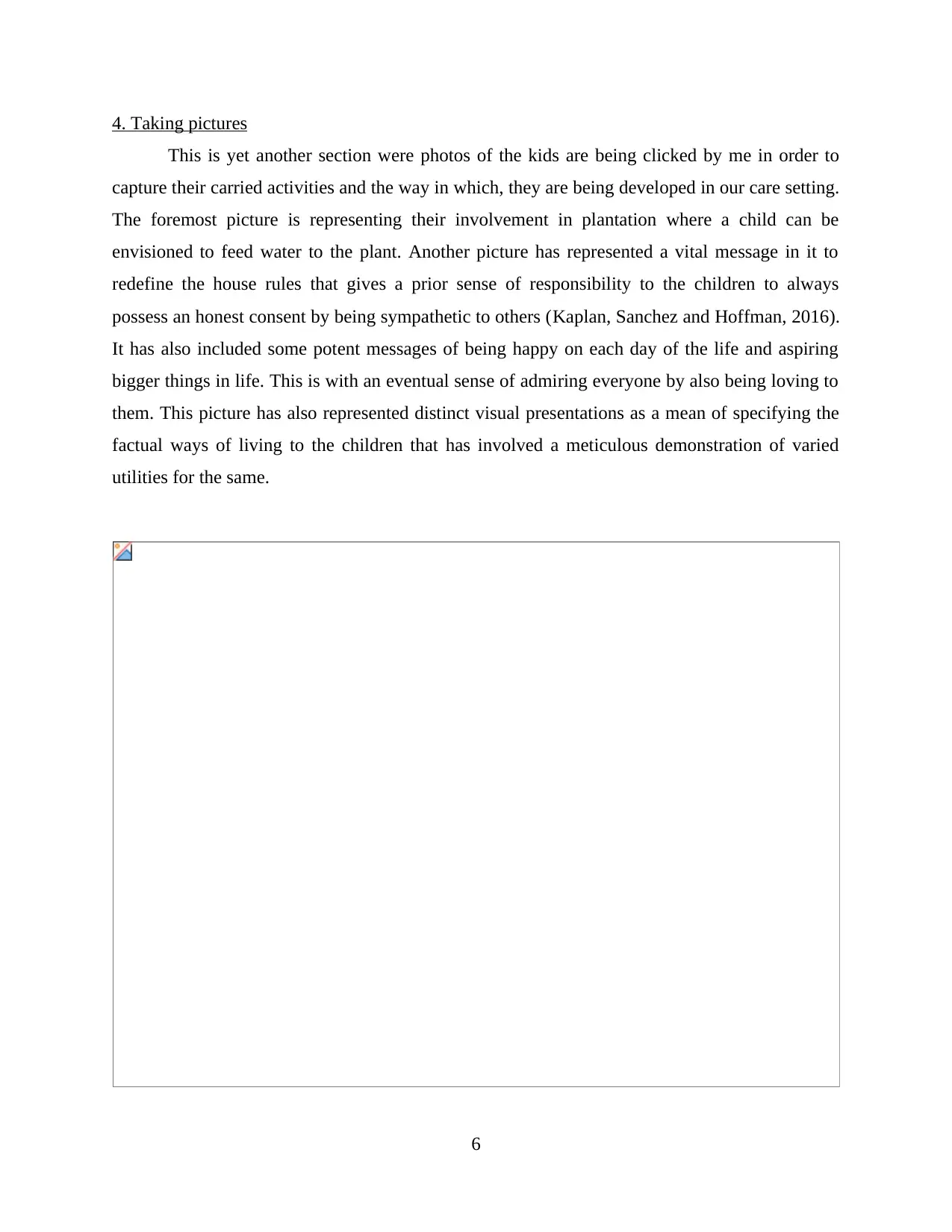
4. Taking pictures
This is yet another section were photos of the kids are being clicked by me in order to
capture their carried activities and the way in which, they are being developed in our care setting.
The foremost picture is representing their involvement in plantation where a child can be
envisioned to feed water to the plant. Another picture has represented a vital message in it to
redefine the house rules that gives a prior sense of responsibility to the children to always
possess an honest consent by being sympathetic to others (Kaplan, Sanchez and Hoffman, 2016).
It has also included some potent messages of being happy on each day of the life and aspiring
bigger things in life. This is with an eventual sense of admiring everyone by also being loving to
them. This picture has also represented distinct visual presentations as a mean of specifying the
factual ways of living to the children that has involved a meticulous demonstration of varied
utilities for the same.
6
This is yet another section were photos of the kids are being clicked by me in order to
capture their carried activities and the way in which, they are being developed in our care setting.
The foremost picture is representing their involvement in plantation where a child can be
envisioned to feed water to the plant. Another picture has represented a vital message in it to
redefine the house rules that gives a prior sense of responsibility to the children to always
possess an honest consent by being sympathetic to others (Kaplan, Sanchez and Hoffman, 2016).
It has also included some potent messages of being happy on each day of the life and aspiring
bigger things in life. This is with an eventual sense of admiring everyone by also being loving to
them. This picture has also represented distinct visual presentations as a mean of specifying the
factual ways of living to the children that has involved a meticulous demonstration of varied
utilities for the same.
6
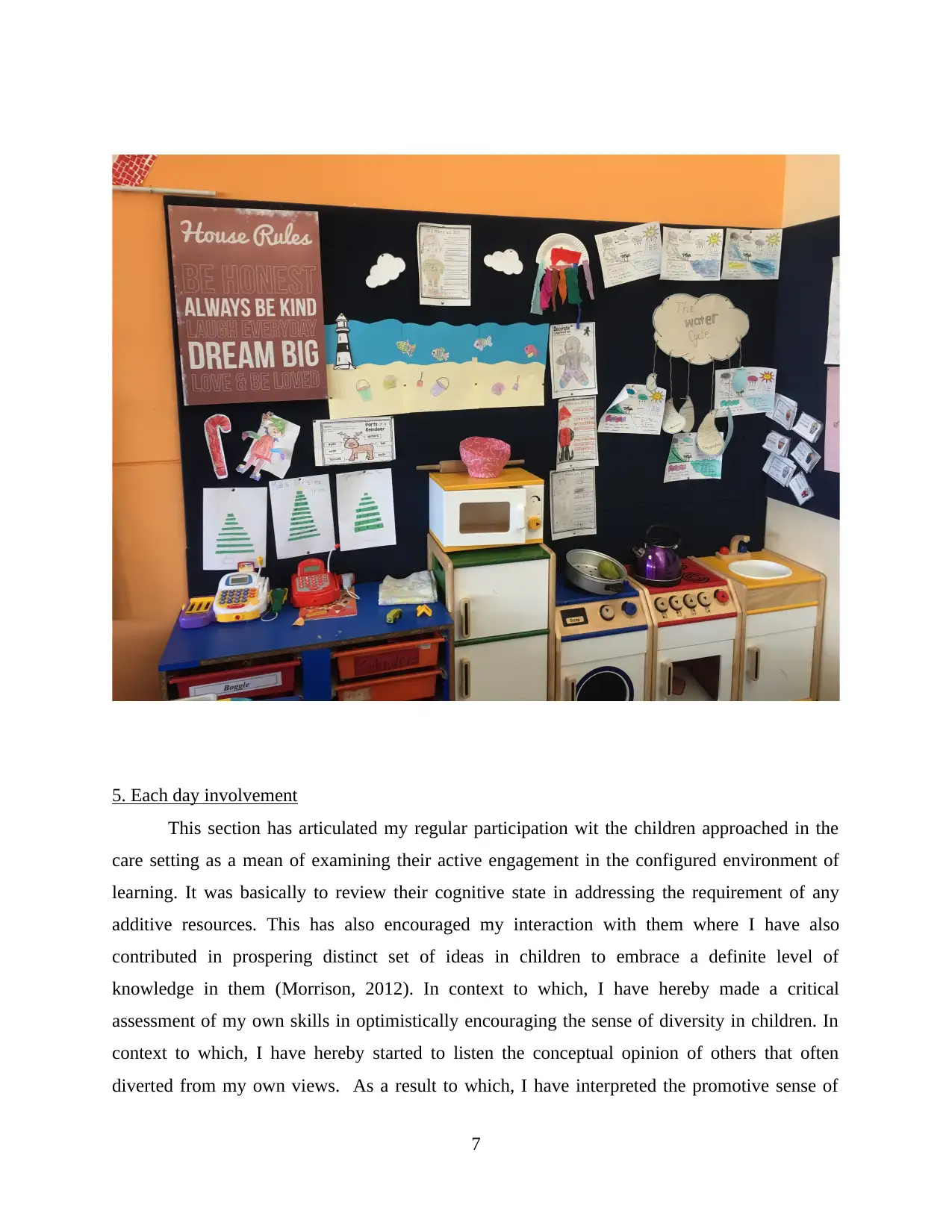
5. Each day involvement
This section has articulated my regular participation wit the children approached in the
care setting as a mean of examining their active engagement in the configured environment of
learning. It was basically to review their cognitive state in addressing the requirement of any
additive resources. This has also encouraged my interaction with them where I have also
contributed in prospering distinct set of ideas in children to embrace a definite level of
knowledge in them (Morrison, 2012). In context to which, I have hereby made a critical
assessment of my own skills in optimistically encouraging the sense of diversity in children. In
context to which, I have hereby started to listen the conceptual opinion of others that often
diverted from my own views. As a result to which, I have interpreted the promotive sense of
7
This section has articulated my regular participation wit the children approached in the
care setting as a mean of examining their active engagement in the configured environment of
learning. It was basically to review their cognitive state in addressing the requirement of any
additive resources. This has also encouraged my interaction with them where I have also
contributed in prospering distinct set of ideas in children to embrace a definite level of
knowledge in them (Morrison, 2012). In context to which, I have hereby made a critical
assessment of my own skills in optimistically encouraging the sense of diversity in children. In
context to which, I have hereby started to listen the conceptual opinion of others that often
diverted from my own views. As a result to which, I have interpreted the promotive sense of
7
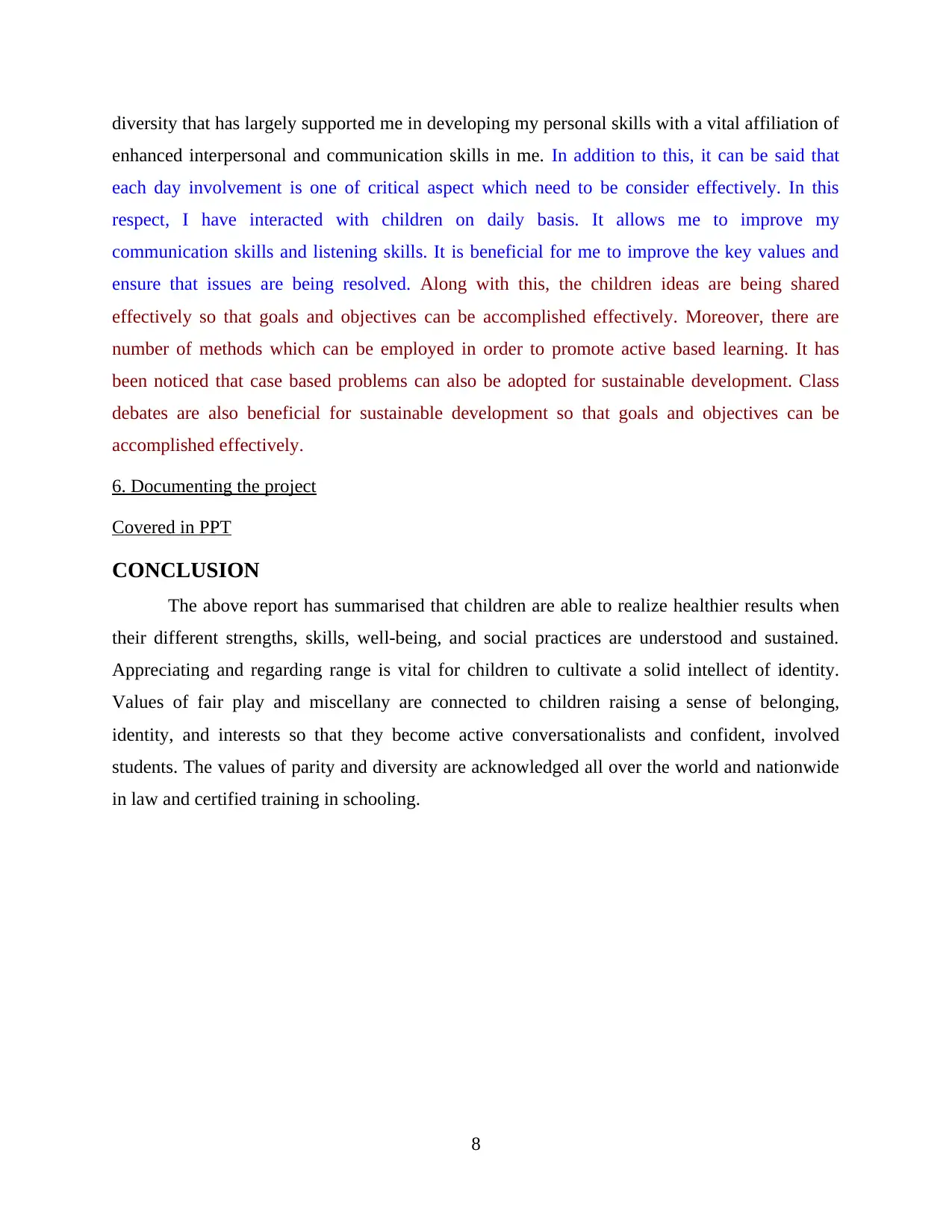
diversity that has largely supported me in developing my personal skills with a vital affiliation of
enhanced interpersonal and communication skills in me. In addition to this, it can be said that
each day involvement is one of critical aspect which need to be consider effectively. In this
respect, I have interacted with children on daily basis. It allows me to improve my
communication skills and listening skills. It is beneficial for me to improve the key values and
ensure that issues are being resolved. Along with this, the children ideas are being shared
effectively so that goals and objectives can be accomplished effectively. Moreover, there are
number of methods which can be employed in order to promote active based learning. It has
been noticed that case based problems can also be adopted for sustainable development. Class
debates are also beneficial for sustainable development so that goals and objectives can be
accomplished effectively.
6. Documenting the project
Covered in PPT
CONCLUSION
The above report has summarised that children are able to realize healthier results when
their different strengths, skills, well-being, and social practices are understood and sustained.
Appreciating and regarding range is vital for children to cultivate a solid intellect of identity.
Values of fair play and miscellany are connected to children raising a sense of belonging,
identity, and interests so that they become active conversationalists and confident, involved
students. The values of parity and diversity are acknowledged all over the world and nationwide
in law and certified training in schooling.
8
enhanced interpersonal and communication skills in me. In addition to this, it can be said that
each day involvement is one of critical aspect which need to be consider effectively. In this
respect, I have interacted with children on daily basis. It allows me to improve my
communication skills and listening skills. It is beneficial for me to improve the key values and
ensure that issues are being resolved. Along with this, the children ideas are being shared
effectively so that goals and objectives can be accomplished effectively. Moreover, there are
number of methods which can be employed in order to promote active based learning. It has
been noticed that case based problems can also be adopted for sustainable development. Class
debates are also beneficial for sustainable development so that goals and objectives can be
accomplished effectively.
6. Documenting the project
Covered in PPT
CONCLUSION
The above report has summarised that children are able to realize healthier results when
their different strengths, skills, well-being, and social practices are understood and sustained.
Appreciating and regarding range is vital for children to cultivate a solid intellect of identity.
Values of fair play and miscellany are connected to children raising a sense of belonging,
identity, and interests so that they become active conversationalists and confident, involved
students. The values of parity and diversity are acknowledged all over the world and nationwide
in law and certified training in schooling.
8
Paraphrase This Document
Need a fresh take? Get an instant paraphrase of this document with our AI Paraphraser
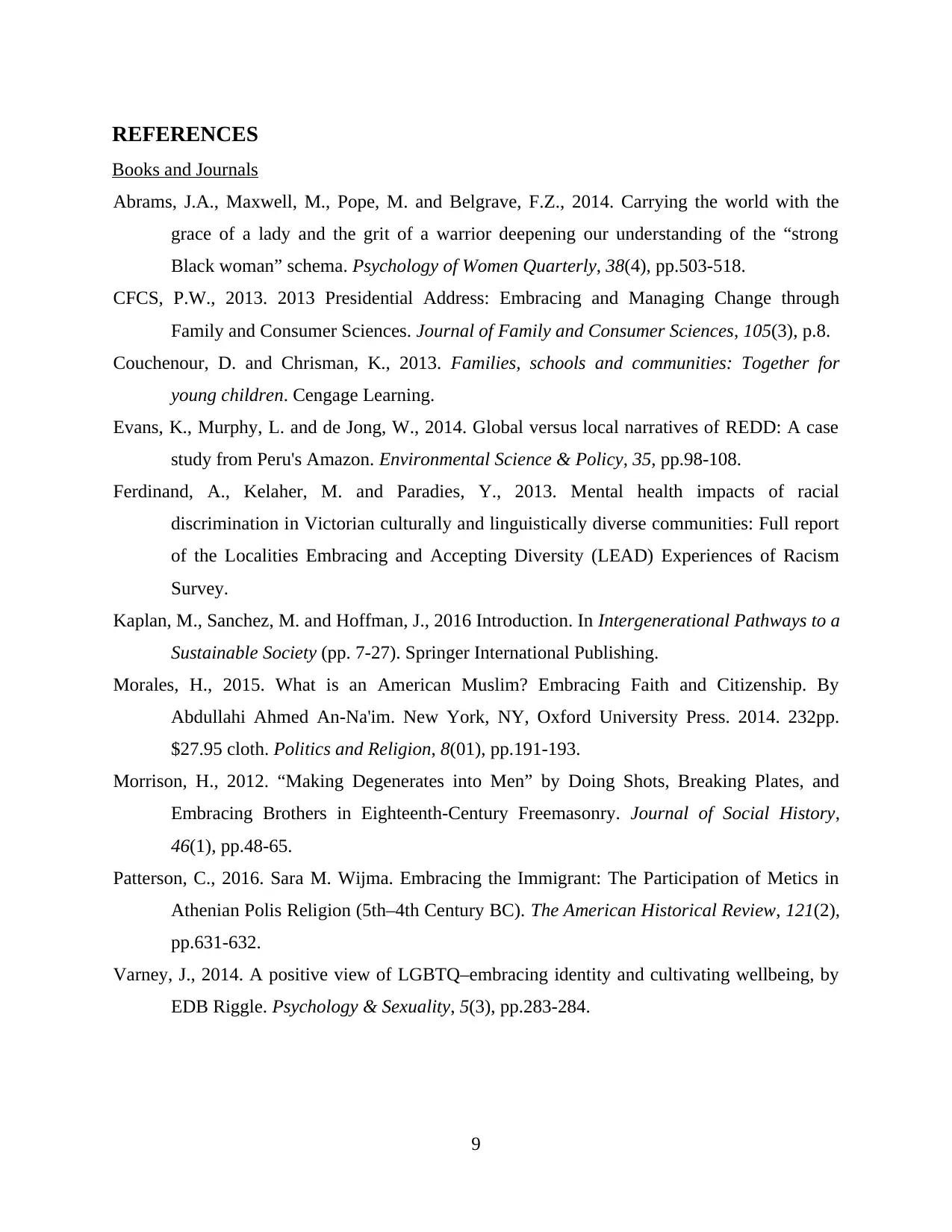
REFERENCES
Books and Journals
Abrams, J.A., Maxwell, M., Pope, M. and Belgrave, F.Z., 2014. Carrying the world with the
grace of a lady and the grit of a warrior deepening our understanding of the “strong
Black woman” schema. Psychology of Women Quarterly, 38(4), pp.503-518.
CFCS, P.W., 2013. 2013 Presidential Address: Embracing and Managing Change through
Family and Consumer Sciences. Journal of Family and Consumer Sciences, 105(3), p.8.
Couchenour, D. and Chrisman, K., 2013. Families, schools and communities: Together for
young children. Cengage Learning.
Evans, K., Murphy, L. and de Jong, W., 2014. Global versus local narratives of REDD: A case
study from Peru's Amazon. Environmental Science & Policy, 35, pp.98-108.
Ferdinand, A., Kelaher, M. and Paradies, Y., 2013. Mental health impacts of racial
discrimination in Victorian culturally and linguistically diverse communities: Full report
of the Localities Embracing and Accepting Diversity (LEAD) Experiences of Racism
Survey.
Kaplan, M., Sanchez, M. and Hoffman, J., 2016 Introduction. In Intergenerational Pathways to a
Sustainable Society (pp. 7-27). Springer International Publishing.
Morales, H., 2015. What is an American Muslim? Embracing Faith and Citizenship. By
Abdullahi Ahmed An-Na'im. New York, NY, Oxford University Press. 2014. 232pp.
$27.95 cloth. Politics and Religion, 8(01), pp.191-193.
Morrison, H., 2012. “Making Degenerates into Men” by Doing Shots, Breaking Plates, and
Embracing Brothers in Eighteenth-Century Freemasonry. Journal of Social History,
46(1), pp.48-65.
Patterson, C., 2016. Sara M. Wijma. Embracing the Immigrant: The Participation of Metics in
Athenian Polis Religion (5th–4th Century BC). The American Historical Review, 121(2),
pp.631-632.
Varney, J., 2014. A positive view of LGBTQ–embracing identity and cultivating wellbeing, by
EDB Riggle. Psychology & Sexuality, 5(3), pp.283-284.
9
Books and Journals
Abrams, J.A., Maxwell, M., Pope, M. and Belgrave, F.Z., 2014. Carrying the world with the
grace of a lady and the grit of a warrior deepening our understanding of the “strong
Black woman” schema. Psychology of Women Quarterly, 38(4), pp.503-518.
CFCS, P.W., 2013. 2013 Presidential Address: Embracing and Managing Change through
Family and Consumer Sciences. Journal of Family and Consumer Sciences, 105(3), p.8.
Couchenour, D. and Chrisman, K., 2013. Families, schools and communities: Together for
young children. Cengage Learning.
Evans, K., Murphy, L. and de Jong, W., 2014. Global versus local narratives of REDD: A case
study from Peru's Amazon. Environmental Science & Policy, 35, pp.98-108.
Ferdinand, A., Kelaher, M. and Paradies, Y., 2013. Mental health impacts of racial
discrimination in Victorian culturally and linguistically diverse communities: Full report
of the Localities Embracing and Accepting Diversity (LEAD) Experiences of Racism
Survey.
Kaplan, M., Sanchez, M. and Hoffman, J., 2016 Introduction. In Intergenerational Pathways to a
Sustainable Society (pp. 7-27). Springer International Publishing.
Morales, H., 2015. What is an American Muslim? Embracing Faith and Citizenship. By
Abdullahi Ahmed An-Na'im. New York, NY, Oxford University Press. 2014. 232pp.
$27.95 cloth. Politics and Religion, 8(01), pp.191-193.
Morrison, H., 2012. “Making Degenerates into Men” by Doing Shots, Breaking Plates, and
Embracing Brothers in Eighteenth-Century Freemasonry. Journal of Social History,
46(1), pp.48-65.
Patterson, C., 2016. Sara M. Wijma. Embracing the Immigrant: The Participation of Metics in
Athenian Polis Religion (5th–4th Century BC). The American Historical Review, 121(2),
pp.631-632.
Varney, J., 2014. A positive view of LGBTQ–embracing identity and cultivating wellbeing, by
EDB Riggle. Psychology & Sexuality, 5(3), pp.283-284.
9
1 out of 11
Related Documents
Your All-in-One AI-Powered Toolkit for Academic Success.
+13062052269
info@desklib.com
Available 24*7 on WhatsApp / Email
![[object Object]](/_next/static/media/star-bottom.7253800d.svg)
Unlock your academic potential
© 2024 | Zucol Services PVT LTD | All rights reserved.





